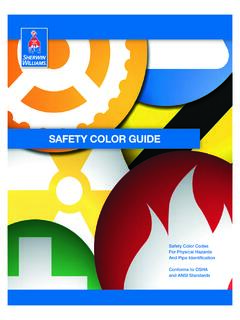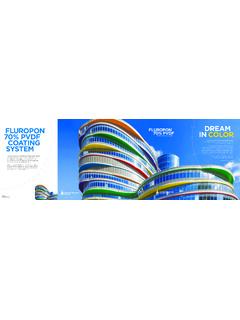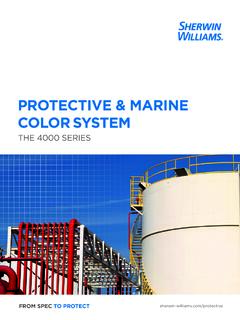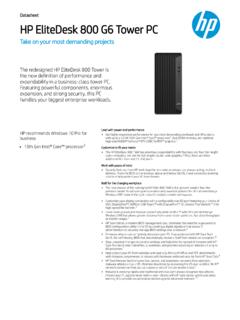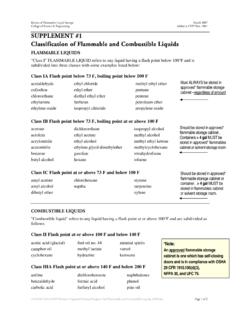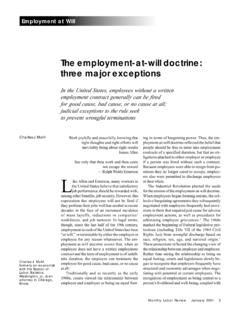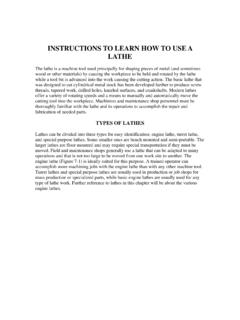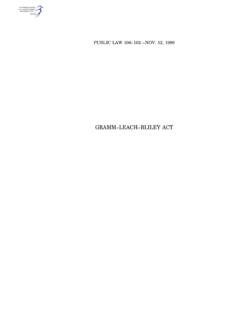Transcription of Epoxy Coatings Guide - Sherwin-Williams
1 Epoxy Coatings GUIDEE poxy ResinsCo-Reactant or Hardeners Types: Polyamide, Aromatic Amine, Amidoamine, Aliphatic Amine, Cycloaliphatic Amine, Aliphatic Amine AdductEpoxy Coatings are generally packaged in two parts that are mixed prior to application. The two parts consist of 1) an Epoxy resin which is cross-linked with 2) a co-reactant or hardener. Epoxy Coatings are formulated based upon the performance requirements for the end product. When properly catalyzed and applied, epoxies produce a hard, chemical and solvent resistant finish. They are typically used on concrete and steel to give resistance to water, alkali and is the specific selection and combination of the Epoxy component and the hardener component that determines the final characteristics and suitability of the Epoxy coating for a given TypesViscosityFlexibilityChemical ResistanceBisphenol A Bisphenol F Phenolic NovolacModerate High Moderate Moderate HighModerate Low Moderate LowModerate Moderate HighFEATURES [co-reactants and hardeners rated top to bottom from best suited to least suited]
2 Film FlexibilityAdhesionChemical ResistanceAcidsSolventsWaterBestPolyamid e Amidoamine Phenalkamine Cycloaliphatic Amine Aromatic Amine Aliphatic Amine Adducts Aliphatic AmineBestPolyamide Phenalkamine Amidoamine Cycloaliphatic Amine Aliphatic Amine Aliphatic Amine Adducts Aromatic AmineBestAromatic Amine Cycloaliphatic Amine Aliphatic Amine Aliphatic Amine Adducts Amidoamine Phenalkamine PolyamideBestAliphatic Amine Aliphatic Amine Adducts Cycloaliphatic Amine Aromatic Amine Polyamide Phenalkamine AmidoamineBestPolyamide Phenalkamine Amidoamine Cycloaliphatic Amine Aromatic Amine Aliphatic Amine Aliphatic Amine AdductsBlush ResistanceColor StabilityLow Temp. ApplicationCorrosion ResistanceViscosityBestPolyamide Phenalkamine Amidoamine Cycloaliphatic Amine Aromatic Amine Aliphatic Amine Adducts Aliphatic AmineBestPolyamide Amidoamine Cycloaliphatic Amine Aliphatic Amine Adducts Aliphatic Amine Phenalkamine Aromatic AmineBestPhenalkamine Aliphatic Amine Aliphatic Amine Adducts Cycloaliphatic Amine Polyamide Amidoamine Aromatic AmineBestPolyamide Amidoamine Phenalkamine Cycloaliphatic Amine Aliphatic Amine Adducts Aromatic Amine Aliphatic AmineBestCycloaliphatic Amine Aliphatic Amine Amidoamine Aromatic Amine Aliphatic Amine Adducts Phenalkamine PolyamideCommon Causes for Irregularities and Finish DefectsPolyamide/Amine Blush or Surface EnrichmentOccurs when the proper cure cycle of catalyzed epoxies is interrupted or slowed.
3 The lighter polyamide or amine hardener separates from the Epoxy and floats to the surface where it oxidizes and turns yellow or brownish in By:The polyamide/amine blush can be confirmed by rubbing the surface lightly with a clean rag saturated with MEK or Reducer R7K54. The yellow appearance will be removed, but may later return. Caused By:Improper Mixing Areas rich in polyamide or amine content may exhibit yellowing/blushing and/or an oily exudate Areas rich in Epoxy content will appear normal in color for a period of time, but may eventually discolor May result in color variations along the same coated surface Drying and curing times may be affectedImproper HardenerEpoxy Coatings are formulated with optimum levels of a hardener for a given level of Epoxy resin. This ratio differs from product to product. The use of an improper hardener may result in an undercatalyzed or overcatalyzed Films: May appear dry but will not fully cure May appear soft and gummy Overcatalyzed Films: May be hard and brittle Both will result in discoloration, yellowing, and reduced performance propertiesInsufficient Induction (Sweat-In Time)Many Epoxy Coatings require a specified induction time in order to fully compatibilize the Epoxy resin and the hardener.
4 When required, this pre-reaction will reduce the likelihood of poor film appearance and poor coating performance. Lower temperatures and/or high humidity will generally require longer induction inducted epoxies will exhibit: A lower gloss than expected Y ellowing becoming progressively worse over time Polyamide/amine blushing Reduced chemical resistance Softer film Color float and/or color variationIt is possible that the coating material applied initially may develop low gloss and discolor, while the rest of the surface, painted with the same material, will appear normal as induction time has TemperatureMost epoxies are formulated for application at temperatures above 50 55 F. Temperatures below 50 F will stop the rate of the chemical reaction between the Epoxy and the hardener. The evaporation of the solvents in the coating are also inhibited. Both of these conditions will increase the likelihood of blushing, discoloration and down-glossing.
5 Be aware that surface temperatures may be much lower than the air temperature. Epoxy Coatings should never be applied below the recommended temperature range, or when temperatures are expected to fall below the minimum recommended temperature during the first 72 hours of Humidity, Moisture Condensation, Stagnant Air Most epoxies are designed for application up to a maximum 85% RH. High humidity and/or the presence of moisture may cause discoloration or a greasy feel and poor uniformity of appearance. The polyamide/amine may separate and cause discoloration. Maximum effort should be made to increase fresh air circulation to minimize this Curing of Water-Based Primers or Fillers If water-based primers are not sufficiently cured prior to topcoating, moisture migrating through the fresh Epoxy film will inhibit the drying and curing of the Epoxy . This will cause discoloration, low gloss and possibly Causes for Irregularities and Finish DefectsDiscoloration from Exposure UV Light (Sunlight) This is a surface phenomenon attributed to the natural darkening of Epoxy resin upon exposure to UV or sunlight.
6 This problem occurs most often in areas with intermittent sunlight, creating a checkerboard effect. The discoloration may be confirmed by scraping away the surface layer with a knife to expose the underlying film which will appear lighter in from Chemical Exposure Certain chemical compounds, such as carbon monoxide and carbon dioxide, are known to react with freshly applied Epoxy films and cause discoloration. This discoloration will be more pronounced in areas of high film build and in areas with little or no air circulation. Check area for cleaning agents that may contain these compounds. Animal kennels or shelters are also suspect because of waste Finishes: Resistance to YellowingPRODUCT [epoxies rated top to bottom from best resistance to least resistance]Polysiloxane XLE-80 Pro Industrial Hi-Bild Waterbased Epoxy Water-Based Catalyzed EpoxyTile-Clad HS Epoxy Water-Based Tile-CladPro Industrial High Performance Epoxy Epolon II Multi-Mil EpoxyMacropoxy HS Epoxy Macropoxy 646 Fast Cure EpoxyHigh Solids Catalyzed Epoxy Macropoxy 846 Winter Grade EpoxySher-Glass FF Tank Clad HS EpoxyDuraplate 301 Dura-Plate 235 Best ResistanceLeast ResistanceKey Issues to Consider During Selection and Use of EpoxiesSubstrate Types.
7 Steel, concrete, etc. Is it suitable for the coating and the environmental exposure?Surface Prep. Are the requirements adequate? Temperature/Variations. Normally above 55 F for the first 72 hours of drying, and at least 5 F above the dew point. Humidity. Normally below 85% Exposure. Is the coating suitable for the conditions it will be exposed to?Performance Requirements. What performance characteristics will the coating be exposed to? ( abrasion, flexibility, heat resistance, etc.)Recoatability. Will it be required and within what time frame?Application Methods. Is the coating designed for the specific method? ( spray, brush, roll, squeegee/trowel)Cost/Value Considerations. Cost per mil per square foot per year of life Build. Is the coating able to comply with the specifications?Air Movement. It is very important to have fresh air circulating over the surface during Time.
8 Critical, especially during cold weather and high Life. Do not exceed. Coating may appear usable but will exhibit poor Be aware that some epoxies yellow more than others. More noticeable in whites and Will odor be a concern in or around the application area? Solvent-based, water-based, high solids : Common Problems and Most Probable CausesCommon ProblemsMost Probable CausesSurface ContaminationApplication MethodExceeded Pot LifeHigh HumidityImproper HardenerSweat-In TimeRecoat TimeTint LevelImproper Mix RatioUV Light ExposureAbsence of LightExposure to ChemicalsWrong Reducer SolventPercent ReductionMoisture/CondensationProduct SelectionApplication TemperatureSurface TemperatureInitial Temperature 72 ThicknessAir MovementBatch VariationPrimerSurface PreparationDiscoloration/Yellowing Color Variation Blushing Uneven Gloss Exotherm (Hot Paint)
9 Poor Intercoat Adhesion Soft Film Tacky Film/Slow Dry Lifting/Wrinkling Bleeding Pinholing Cratering Low Film Thickness Sagging Cracking/Crazing Alligatoring Epoxy Coating Comparison ChartAMINE EPOXIESPOLYAMIDE EPOXIESAMIDOAMINE EPOXIESEPOXYPHENOLICS/NOVOLACSD escriptionForm very hard, adherent films with excellent chemical and corrosion resistance. Amine cured epoxies are often used as protective Coatings and linings in highly corrosive environments. Amine epoxies require care in handling since the amines can be moderately irritating to the skin, and may cause allergic epoxies generally offer the widest latitude in coating formulation. They are considered more resilient and flexible, and have better weathering resistance and a longer pot life than amine cured epoxies. Polyamide epoxies generally have less solvent and acid resistance than amine cured are reaction products of a polyamine and a fatty acid.
10 Their properties generally fall between those of amines and polyamides. They have good water and corrosion resistance like amines, and good toughness like polyamides. They have relatively small molecular size giving them low viscosities and making them very good surface Coatings allow wide range formulating latitude. Novolac Epoxy resin increases chemical resistance and solvent resistance. Increasing the level of phenolic increases the chemical and solvent resistance, but the coating loses flexibility. Some phenolics require heat Excellent alkali and water resistance V ery good acid resistance Excellent solvent resistance Hard, abrasion resistant film Excellent corrosion resistance Excellent wetting of substrate Chemical/moisture barrier V ery good alkali and water resistance Good acid resistance Longer pot life than amines Easy to apply Cures more quickly than amines Good weathering characteristics Good film flexibility Excellent adhesion Excellent surface wetting Excellent adhesion Excellent water resistance Low viscosity Longer pot life than amines Good gloss retention High heat resistance Excellent chemical resistance Excellent solvent resistance Excellent corrosion resistance Hard.
